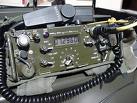Radios used in military
2008-08-20
Radios used in military Radio used in military already has a long history. The radio came of age during World War I. Military leaders recognized its value for communicating with the infantry and ships at sea. During the WWI, much advancement was made to the radio making it more powerful and compact. In 1923, Edwin Armstrong invented the super heterodyne radio. It was a major advancement in how a radio worked. The basic principles used in the super heterodyne radio are still in use today. A military radio in its general definition is one used by any branch of the armed forces by a nation. The radio can be specifically designed for military use, or a civilian model drafted into service for various wartime and peacetime uses. It like to use the categories laid out originally by the Signal Corps, a military group originally tasked with visual signaling, later wire-line field telephone communication and finally radio communication. The function of the radio can be broken down into down into three broad user groups. Ground: Field offices, mobile radios and squad level portables (green radios) Air: This involves both air to air and ground to air (black radios) Sea: This involves ship to ship and ship to shore radios fixed, mobile.

As today's battlefield conditions change, military communications are rapidly evolving. Specialized radio systems operate in the spectrum between DC and light wave. Specific frequencies depend on radio-wave propagation performance. Different to common radios, military radios have their own Performance indicators: * Information Form: Traditional voice and low-speed data are being augmented with high-speed data, fax, and video. Of these, video yields the greatest increase in performance. Some of the latest digital video-imaging transmission systems let high-resolution color still-frame images be reliably transmitted via any narrowband 3-KHz circuit. Even the most difficult multiple-hop HF sky wave path may be used. Integrated with radios in many of these systems are data compression; high-speed modems with forward error correction, interleaving, and adaptive channel equalization; and video-control algorithms. Military users interested in video include special-operations forces and federal agencies fighting the war on drugs. * Information Security: Information transmitted via radios has traditionally been protected using separate boxes. New technologies now allow substantial reduction in the hardware necessary to perform the security function. These devices can be embedded within the radio, substantially reducing the volume, weight, and power for a user, especially a tactical user. Systems employing crypto devices can include frequency hopping, spread spectrum, low probability of intercept detection, RF power optimization, and burst transmission. * Acceptable Error Performance: Complex mathematical algorithms are now being implemented with DSP techniques. High-speed closed-loop automatic repeat-request systems are specified when 100% accuracy is mandatory. This results in a more reliable system than those implementing a forward-error-correction algorithm only. * Mission-Suitability and Physical Characteristics: Newer equipment must be smaller and lighter. It must consume less power and provide tremendously increased performance. As a comparison, it is possible to package an HF radio with high-speed data, automatic link establishment (ALE), 800-Hz LPC voice digitization, encryption, and a frequency-hopping controller--all in a shoebox-size case. A comparable capability in the mid-1980s required a 6-foot rack of equipment. Electromagnetic pulse (EHP) filters are also being incorporated. Operation over multiple-frequency bands, with corresponding modulation modes, is becoming the norm. Thus, radios operate over all or portions of the SSB, LB VHF, high-band VHF and UHF frequency bands. * Simple Operation: HF equipment interface has been made routine by implementation of ALE. The U.S. government has released a MILSPEC governing this protocol. NATO is working on a comparable STANAG standard. This ALE process performs HF circuit connectivity, making HF operation as routine as other line-of-sight VHF/UHF circuits. With the rapid development of the technology, the developing radios will take more merits for the contemporary military.



